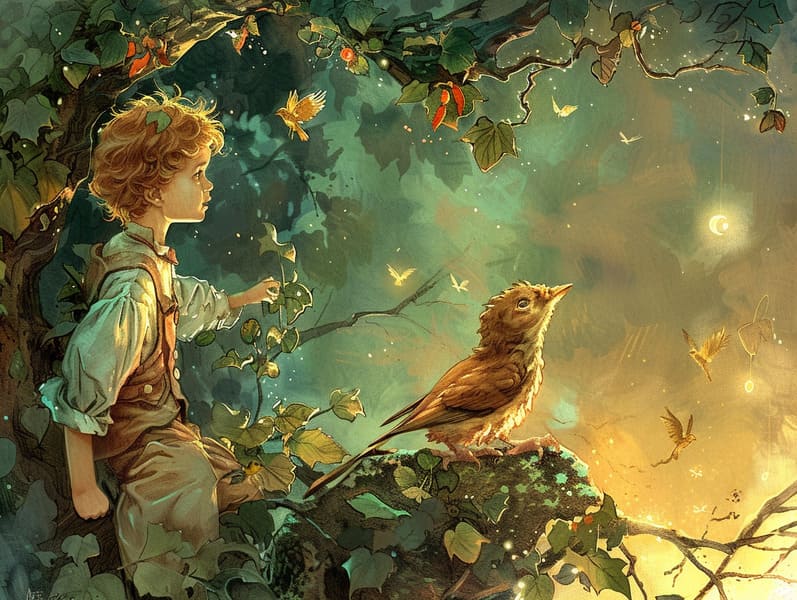
Traditional fairy tales have timeless appeal. These stories have been told from one generation to the next far before they were ever transcribed. They arose from a variety of societies, including Western traditions. They were initially told among older generations, often carrying themes and messages mirroring the societal norms and beliefs of the time.
The Brothers Grimm, Jacob and Wilhelm, were among the first to gather many of these beloved stories. Their volume, "Grimm's Fables," included narratives like "Ashenputtel," "The Bread Crumb Trail," and "Snow White," which have since become classics in the world of classic fairy tales. Similarly, Andersen's charming fairy tales, such as "The Mermaid," and "The Ugly Duckling," have won hearts worldwide, ensuring their place in the pantheon of timeless fairy tales.
Despite their ancient origins, traditional fairy tales remain as impactful as ever, especially as children's bedtime stories. These delightful tales are now available in numerous formats, including vividly illustrated books, magical animations, and free fairy tales online.
Their persistent charm can be ascribed to several fascinating points:
Key Lessons: Old fairy tales often impart important moral lessons. Tales like "The Wolf and the Liar" teach the merit of integrity, while "The Tortoise and the Hare" demonstrate the benefits of perseverance and meekness. These narratives offer kids clear distinctions between virtue and vice, guiding their moral compass in a soft yet significant way.
Compassion and Insight: Traditional fairy tales frequently feature protagonists facing challenges and struggles, inciting audiences to sympathize with their struggles and cheer for their triumphs. For instance, "Beauty's Beast" reveals the importance of looking past the exterior to perceive the inner core of a being, encouraging insight and understanding.
Cultural Recognition: Many fairy tales are rich in the cultural contexts from which they came. Learning from these narratives can provide captivating looks into different heritages, encouraging a sense of global awareness and acknowledgment.
Fantasy and Innovation: The fantastical elements in timeless fairy tales—talking animals—ignite children’s inventiveness. These tales take readers to mythical realms, encouraging innovative ideas and a sense of enchantment that stays a lifetime.
Traditional fairy tales are not only charming but also enlightening. They provide captivating tools in nurturing various intellectual and emotional capacities in children. When old fairy tales are spoken out loud, they advance speaking abilities by showing new linguistic elements and sophisticated sentence structures. This practice also boosts listening abilities and mental focus, as young readers follow the story, eager to see what happens next.
Furthermore, reflecting on the themes and Grimm's fairy tales collection characters of traditional fairy tales can develop analytical skills and intellectual skills. Children are shown to identify patterns, foresee events, and comprehend cause and effect. These discussions also encourage the young express their thoughts and feelings, cultivating their emotional intelligence.
In today’s information age, the accessibility of internet fairy tales has made these fairy tales more obtainable than ever. Online resources and digital apps provide extensive collections of traditional fairy tales that can be accessed or listened to anytime, anywhere. Fairy tales read out loud are particularly favored, sharing an entertaining method for the young to enjoy these whimsical stories. Spoken stories and read-to-me videos bring characters and settings to life, often joined by captivating musical scores and tunes that enhance the story adventure.
The everlasting appeal of old fairy tales lies in their ability to adjust to present days while continuing with their central values. Contemporary modernizations of these fairy tales often include more varied figures and modern settings, making them relatable to today’s audience. However, the central morals of gallantry, sympathy, and fairness remain unchanged, continuing to influence young readers of all ages.
Old fairy tales also offer a sense of coziness and knowability. They extend a organized narrative with a obvious beginning, middle, and end, often drawing to a close with the finalization of conflicts and the triumph of righteousness over wickedness. This steadiness can be comforting for the young, extending a sense of invariability in an dynamic world.
Ancient fairy tales continue to spellbind and inform new generations, maintaining their splendor and applicability in modern society. As children's night stories, they present a perfect blend of wonder and wisdom, boosting moral values, empathy, and creativity. The presence of online storybooks and the commonness of fairy tales told out loud make sure that these traditional tales remain attainable to new generations.
By keeping and making known these fairy tales, we continue to cherish the rich tapestry of mythology and cultural heritage. Whether you are accessing a vibrantly illustrated book, browsing a web-based library, or listening via an voice book, the grandeur of timeless fairy tales is always within reach. These stories emphasize of the consistent magic of narratives and its ability to link us across time and space.
No matter if you are browsing a richly illustrated book, enjoying a digital library, or listening through an sound book, the captivation of timeless fairy tales is always within reach.
These fairy tales illustrate of the everlasting power of tales and its ability to unite us across time and space, casting a charm that enchants and educates alike.